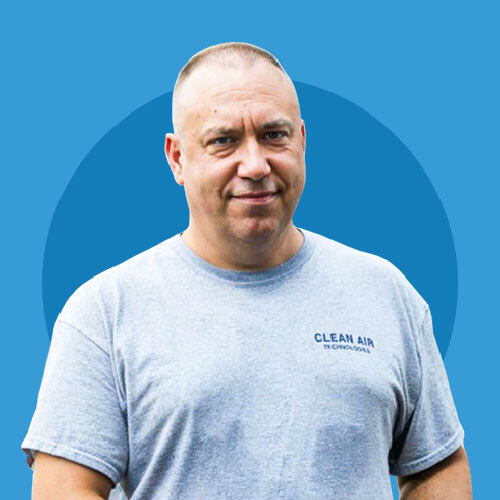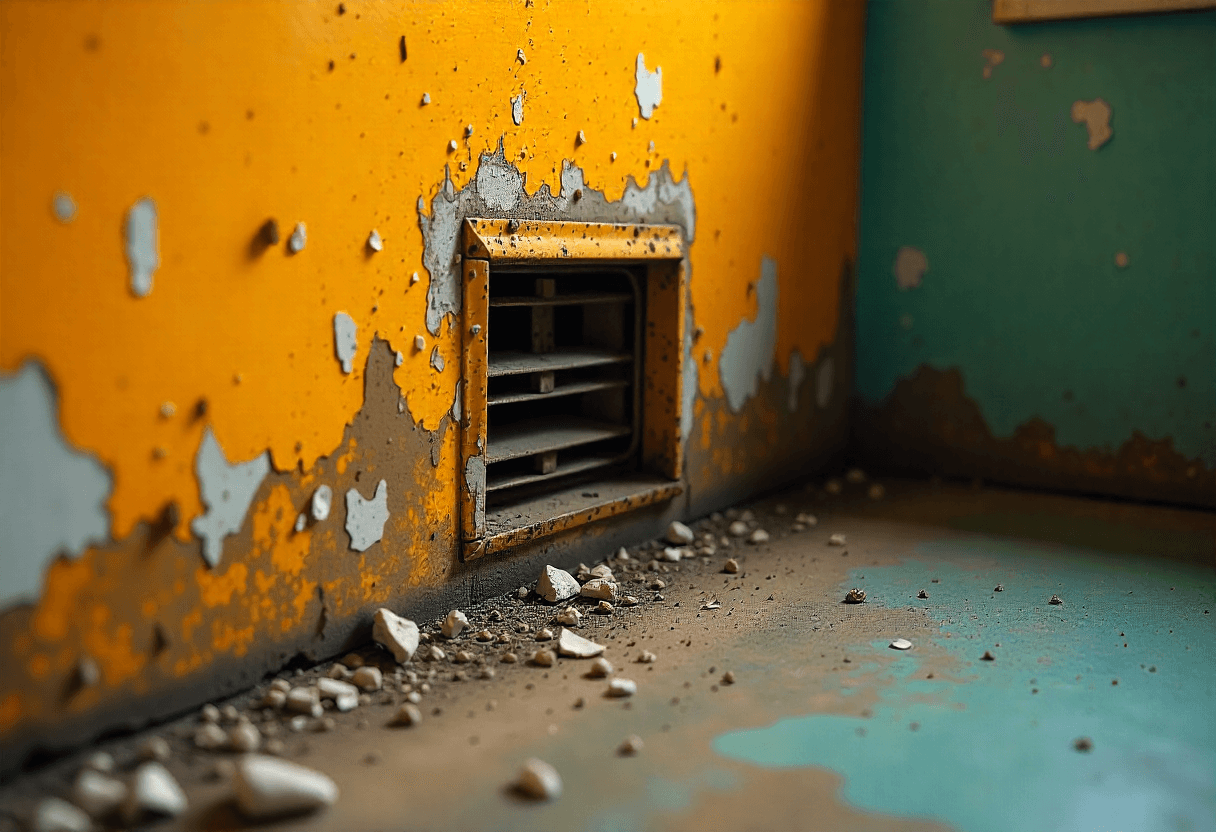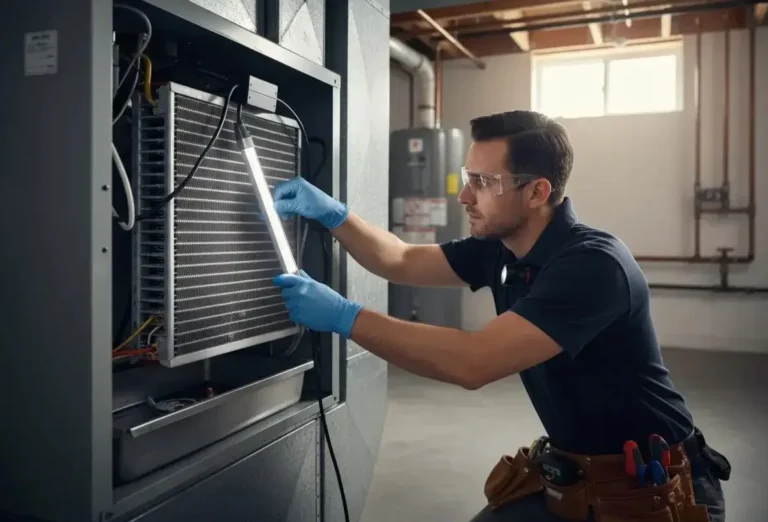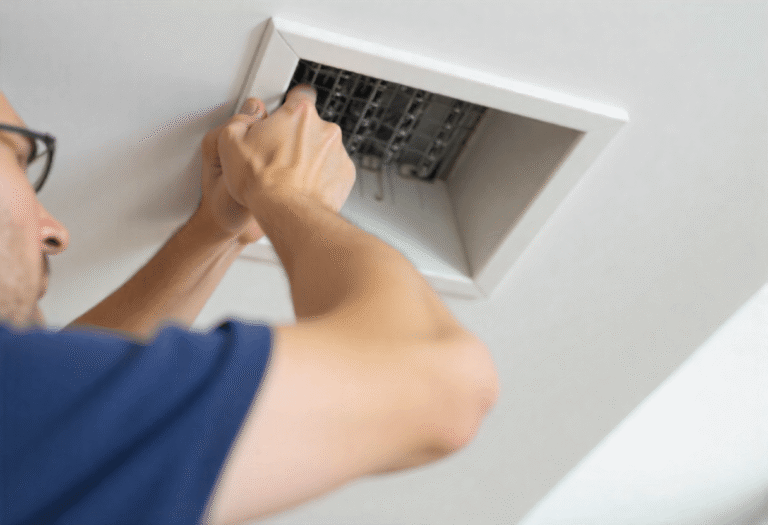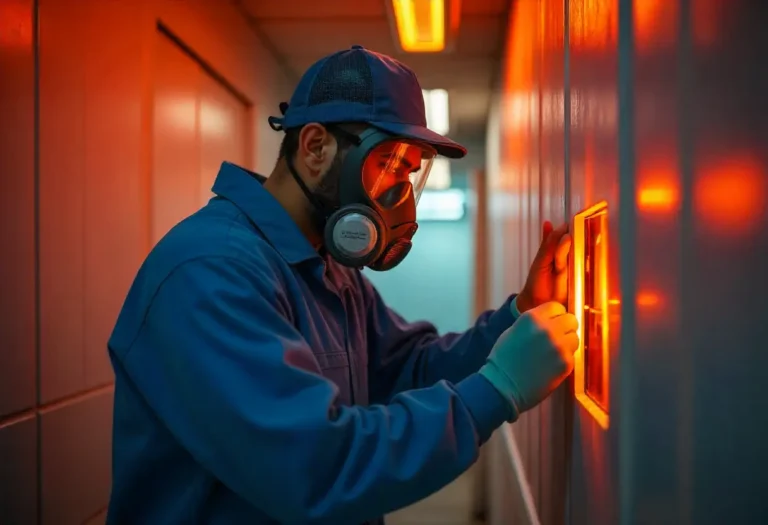We’ve all noticed that weird musty smell every time our AC kicks on. In fact, a lot of us even end up sneezing or feeling congested breathing this air.
And while we think of dust and debris as probable causes, what we don’t realize is it might be mold hiding inside your air ducts. After all, with nearly 47% of all homes being mold infested, this is more common than you think.
What’s worse?
Mold in your air ducts isn’t just gross, it can mess with your health, make allergies worse, and even wear down your HVAC system.
So, how to get rid of mold in air ducts?
In this guide, I will walk you through exactly that. You’ll learn:
- How to spot signs of mold in your vents
- What causes mold to grow inside ductwork
- 8-Step guide for safe mold removal
- When it’s time to get professional help
- And how to keep mold from coming back for good
Let’s get started.
Key takeaways
- Musty smells or allergy symptoms can be signs of mold in your air ducts.
- DIY cleaning works only for small surface-level mold near vent covers.
- Use HEPA vacuums, EPA-approved mold cleaners, and full protective gear.
- Bleach is not safe or effective for HVAC duct mold removal.
- Call a professional if mold keeps coming back or spreads system-wide.
- Prevent future mold with humidity control, filter changes, and yearly HVAC checkups.
How to know if there is mold in air ducts?

If you ever smell something musty when your AC kicks on, there’s a chance your air ducts have mold.
You see, mold doesn’t always look black and fuzzy like you’d expect. In fact, a lot of times, the signs are very subtle.
And the most common giveaway is that earthy and damp smell when the air con starts running. It might come and go, but it usually sticks around just long enough to make your nose crinkle.
Now, you might mistake it for stale air. But if it triggers sneezing fits or makes your eyes itch, it is likely mold.
In some cases, you might actually see visible mold around your vents in the form of little black or green spots on or near the grilles.
Sometimes this buildup starts with dust and moisture collecting around the vent edges, and having an experienced air vent cleaner handle routine maintenance can help prevent mold from developing in the first place.
That’s a clear warning sign.
However, most of the time, it’s hiding deeper in the system, where it’s dark, humid, and almost impossible to check without tools.
So your best bet is to trust your instincts whenever you smell foul odor or sneeze unusually more and call in a professional to inspect your ductwork.
Also, there are simple DIY mold test kits you can buy online or at your local hardware store. These don’t give lab-level results, but they can confirm if mold is likely present.
How to get rid of mold in air ducts?

Now that you know what are the signs of mold presence, let’s see how to remove mold from air ducts.
For starters, treating mold in air ducts is no rocket science. And with the right tools and procedure, you should be able to do air duct cleaning as good as a professional.
I’ve detailed all the tools you’ll need to procure and steps you’ll need to follow for cleaning mold in air ducts.
Schedule Your Free Estimate Today
Contact us to improve your indoor air
quality with our expert cleaning services in NJ.
First off, get the right tools
If you’re planning to clean in and around your vents, you’ll need the right tools.
And as you do so, take my advice and don’t skip any tool or settle for its substitute. That’s because mold cleanup is a serious health risk if you do it casually.
Here’s exactly what to gather before you start:
| Tool | Purpose |
| N-95 Mask, Gloves, Goggles | Protects you from inhaling spores and exposure to mold or chemicals. |
| Screwdriver | Helps remove vent covers or grilles. |
| HEPA Filter Vacuum | Safely traps mold spores and prevents them from circulating. |
| EPA-Registered Mold Cleaner | Specifically formulated to kill mold and mildew safely. |
| Microfiber Cloths/Soft Brushes | Scrubs away mold without damaging duct surfaces. |
| Spray Bottle with Clean Water | Used to rinse off cleaner and mold residue without soaking. |
| Fan or Dehumidifier | Fully dries the cleaned area to prevent mold regrowth. |
Let’s have a closer look:
1. N-95 mask, gloves, and safety goggles
Mold releases spores when disturbed. And breathing them out of dirty ducts can irritate your lungs or trigger allergies.
An N-95 mask helps protect your respiratory system, and gloves and goggles shield your skin and eyes from contact with both mold and cleaning chemicals.
2. Screwdriver
You’ll need a screwdriver to remove vent covers or grilles. That’s because while some vents might pop off with gentle pressure others are secured with visible screws.
3. Vacuum with a HEPA filter
A regular vacuum isn’t safe as it can blow mold spores back into the air. That’s why I suggest you use a HEPA-equipped vacuum as it traps mold particles instead of recirculating them.
4. EPA-registered mold cleaner or disinfectant
Look for a product labeled as a mold-killing antimicrobial cleaner. Avoid bleach as it’s not effective for porous surfaces and can produce harmful fumes.
5. Microfiber cloths or soft scrub brushes
Microfiber and soft scrub brushes hold particles instead of just pushing them around. And they help scrub mold off without damaging your vents.
6. Spray bottle and clean water
Water is used to rinse off residue from both mold and cleaning agents. A spray bottle helps you control moisture and avoid over-soaking.
7. Fan or dehumidifier
The final and crucial step is drying the cleaned area completely. Any leftover moisture can bring the mold right back which is often worse than before.
Now, follow these steps to get rid of mold in air ducts
Once you’ve got all the essential tools, you can follow this 8-step guide and clean your air ducts.
Step 1: Turn off your HVAC system completely
Before you do anything else, switch off your entire heating or cooling system from the thermostat. Then, flip the breaker for added safety.
This is essential because keeping the HVAC on could suck mold spores deeper into the system or blow them into other rooms. And you don’t want mold-infested air blowing back while you clean.
Step 2: Remove vent covers
Use your screwdriver to carefully unscrew the vent covers from the wall or floor. Once removed, set the covers aside as you’ll clean those separately.
Now, look inside the duct opening. Here, if you see mold buildup just beyond the opening, this cleaning method can still help.
But if it’s further in or more widespread than expected, pause and reassess as you might be dealing with a bigger issue that needs professional clean-up.
Step 3: Vacuum the area with a HEPA filter vacuum
Use your vacuum’s hose attachment to remove any loose dust, debris, and surface mold inside and around the duct opening.
I suggest you use a vacuum cleaner with a HEPA filter.
Why?
A HEPA filter traps extremely small particles, including mold spores. Without one, you’re just stirring mold into the air which defeats the whole point of cleaning.
Don’t rush this part. Go slow and thorough, and if your vacuum has a brush attachment, gently use it to break up stubborn dust layers.
Step 4: Spray the moldy area with mold cleaner and let it sit
Now, spray your EPA-approved mold cleaning solution directly onto the moldy surfaces inside the vent and on the vent cover.
Let it sit for 5 to 10 minutes, or as directed on the label, to give the cleaner time to break down the mold.
Never use bleach here as it can damage your metal ductwork. Also, it doesn’t penetrate porous material well which means it might just bleach the color without killing the mold beneath.
Worse, bleach fumes can also mix with other HVAC residues and become toxic.
This is why I suggest using a mold-specific cleaner that says “EPA registered” or “kills mold and mildew.” These are designed for HVAC-safe use and don’t leave dangerous fumes behind.
Step 5: Gently scrub the affected area
Once the mold cleaner has done its part, take a microfiber cloth or soft brush and scrub the area gently.
Start with the vent cover, then move into the visible duct opening as far as your arm comfortably reaches. Use a flashlight if needed.
If the mold comes off easily, that’s a good sign as you’re dealing with surface-level growth only.
Note: Be careful not to scrape too hard or damage the duct coating, especially if it’s fiberglass-lined.
Step 6: Rinse the area with clean water
Lightly mist the scrubbed area using a clean spray bottle filled with water to rinse off any chemical residue.
Then, wipe the surface with a clean microfiber cloth. This step ensures you’re not leaving behind any cleaner that might attract dust or cause further irritation when the HVAC is turned back on.
Step 7: Dry the area completely
This is the step most people skip, but you shouldn’t.
Use a fan or a dehumidifier to fully dry the inside of the vent and the surrounding area. That’s because if the space stays damp, the mold will come right back, sometimes within 24 to 48 hours.
Let the fan run for at least 30 minutes to an hour. And make sure everything, including the vent cover, feels bone dry before moving on.
Step 8: Replace the air filter before restarting the system
This is the perfect time to swap in a fresh, high-quality air filter, ideally a HEPA or MERV-13 rated filter. After all, your old filter might have trapped mold spores, and you don’t want those circulating through your newly cleaned ducts.
Having replaced the air filter, you can reinstall your vent cover and turn the HVAC system back on.
In short: Here’s an 8 step checklist to safely remove mold from air ducts
| Step | Action | Why It Matters |
| 1 | Turn off your HVAC system completely | Prevents mold spores from spreading during cleaning. |
| 2 | Remove vent covers | Gives you access to clean both the cover and duct opening. |
| 3 | Vacuum the duct opening with a HEPA vacuum | Removes loose mold, dust, and spores safely. |
| 4 | Spray EPA-approved mold cleaner on affected areas | Kills mold at the surface before scrubbing. |
| 5 | Gently scrub moldy surfaces using microfiber cloth or soft brush | Removes visible mold without damaging the duct. |
| 6 | Rinse the area lightly with water from a spray bottle | Cleans away leftover chemical residue. |
| 7 | Use a fan or dehumidifier to dry everything thoroughly | Prevents moisture buildup, which is the number one cause of mold return. |
| 8 | Replace your HVAC air filter before turning the system back on | Keeps spores from re-entering the system and improves air quality. |
IMPORTANT NOTE: This method is only for surface-level mold near the vent covers. If you see mold inside the ductwork, or if you smell mold in multiple rooms, stop here and call a professional.
Bonus: Pro tips to prevent mold growth in your air ducts
| Tip | Why It Works |
| Keep humidity below 50% | Mold can’t survive in dry environments |
| Replace filters every 1-3 months | Stops airflow issues and spore spread |
| Annual HVAC inspections | Catches moisture or mold early |
| Seal and insulate ductwork | Prevents condensation and leaks |
| Install UV lights | Kills mold spores before they grow |
Should You DIY or call a professional for cleaning mold in air ducts?

Not sure whether you should tackle the mold in your air ducts yourself or bring in a professional?
In many cases, a simple air quality assessment can help you understand whether the mold is minor enough for DIY or if it’s spread deeper into the system.
You’re not alone as any homeowners struggle with this exact question, especially because mold can be sneaky, expensive, and a little scary too,
Let me break it down and make it simple for you.
When to do DIY mold cleaning
1. The mold is limited to one or two vents
If it’s just a bit of visible surface mold on a vent cover or just inside the opening, and there’s no sign of it deeper in the system, you can likely handle it yourself.
2. You don’t smell mold throughout the house
Musty smells in multiple rooms may mean it’s spread through the duct system and that’s beyond DIY territory.
3. You have the right protective gear and cleaners
This isn’t a paper towel and Febreze job. You’ll need gloves, mask, eye protection, HEPA vac, and EPA-registered cleaner, plus the patience to do it safely and thoroughly.
4. You’re 100% confident it’s not toxic black mold
If it’s slimy, dark black, or greenish-black and you or anyone in the home has allergies or breathing issues, I strongly suggest you not risk it. That’s a job for a mold cleaning expert and you should let them tackle it.
When to call an air duct cleaning professional
Let’s be honest: Mold in ductwork is a serious hazard for health and wellbeing. And it’s not just you at risk but also your family.
Here are signs you should absolutely bring in a professional:
- The mold keeps coming back, even after cleaning.
- Musty smell spreads across multiple rooms.
- People in your home have worsening asthma, allergies, or unexplained coughing.
- There’s visible mold near the HVAC unit itself (blower motor, coils, drain pan, etc.).
- You see water stains, rust, or standing moisture inside vents or near duct joints.
- Your home recently had water damage, roof leaks, or a major humidity issue.
Here’s a quick comparison of DIY vs professional air duct cleaning
| Criteria | DIY Cleaning | Professional Remediation |
| Cost | Low ($30–$100 in supplies) | Higher ($300–$2500+) |
| Best for | Small, surface-level mold | Widespread or recurring mold |
| Tools used | Basic (HEPA vac, sprays) | Commercial-grade (foggers, vacs) |
| Risks | Incomplete removal, spread | Minimal (if certified company) |
| Guarantee | None | Often includes warranty or report |
| Health protection | Limited (DIY gear) | Full containment + PPE |
Bottom line: You can absolutely try DIY mold removal if it’s a small, visible spot and you’re prepared to do it safely. But if there’s any doubt about the extent of mold contamination, don’t risk your health or HVAC system.
Schedule Your Free Estimate Today
Contact us to improve your indoor air
quality with our expert cleaning services in NJ.
Final words
Mold in your air ducts is a problem you shouldn’t ignore. That’s because it’s not just about the musty smell or black spots around your vents as mold can trigger allergies, worsen asthma, and spread spores through your entire HVAC system.
Now, if it’s just a small, surface-level patch, you know how to get rid of mold in air ducts by following a DIY process. You can:
- Wear protective gear
- Use an EPA-approved mold cleaner (never bleach)
- Vacuum with a HEPA filter
- Scrub gently and dry everything thoroughly
- Replace your air filter
However, if mold is deep inside your ductwork, or if you keep smelling it even after cleaning, it’s time to call in the professionals.
Got more questions or looking to get your air ducts professionally cleaned?
You can get in touch with us!
At Clean Air Technologies, we have been pioneering affordable and clean indoor air solutions for almost three decades now. From homeowners to businesses, and more, we serve all settings throughout New Jersey.
In short, we’ve got all your indoor air quality requirements covered on a budget.
FAQs about how to get rid of mold in air ducts
How can I tell if there’s mold in my air ducts?
Your air ducts likely have mold if you notice the following red flags:
- A persistent musty or mildew-like smell when the HVAC runs
- Black, green, or white specks around your vents or inside duct openings
- Worsening allergies or asthma symptoms at home
- Recent water damage, flooding, or high humidity issues
- Condensation or visible moisture around vents
If you’re unsure, I suggest hiring a mold inspection specialist to confirm it.
Is mold in air vents dangerous to my health?
It can be, especially for sensitive groups.
Mold spores may trigger:
- Allergic reactions (sneezing, coughing, itchy eyes)
- Asthma flare-ups
- Headaches or fatigue
- Skin irritation
- Respiratory issues in infants, elderly, or immunocompromised individuals
Even non-toxic mold can cause problems if it’s allowed to grow unchecked and circulate through your home.
Can I use bleach to kill mold in air ducts?
You should not.
Bleach isn’t recommended for porous surfaces like duct insulation or drywall. It can corrode metal ductwork and doesn’t penetrate deeply enough to kill mold roots.
Instead, use an EPA-registered mold cleaner specifically made for HVAC-safe use.
When in doubt, always err on the safe side — pros have the tools and antimicrobial sprays to fully eliminate the problem.
How much does professional mold removal from ducts cost?
On average, expect to pay between $400–$1,000+ for mold removal from air ducts. But the cost varies depending on:
- Size of your HVAC system
- Severity of mold growth
- Whether duct insulation needs replacement
- Your location and local service rates
Tip: Look for NADCA-certified air duct cleaners with mold remediation experience.
How do I prevent mold from coming back in my HVAC system?
Here’s how you can keep mold away for good:
- Run a dehumidifier in humid areas (aim for less than 50% indoor humidity)
- Change your HVAC filter every 1-3 months
- Get annual HVAC maintenance as professionals can spot moisture issues early
- Seal air leaks to prevent warm air from mixing with cold ducts
- Keep vents clean and dry, especially in bathrooms, kitchens, and basements
Can mold in air ducts affect my pets?
Yes, just like humans can get sick because of dirty mold-infested air ducts, pets can also react to mold spores.
If your dog or cat starts sneezing, scratching, or having respiratory symptoms, indoor mold could be a hidden culprit.
